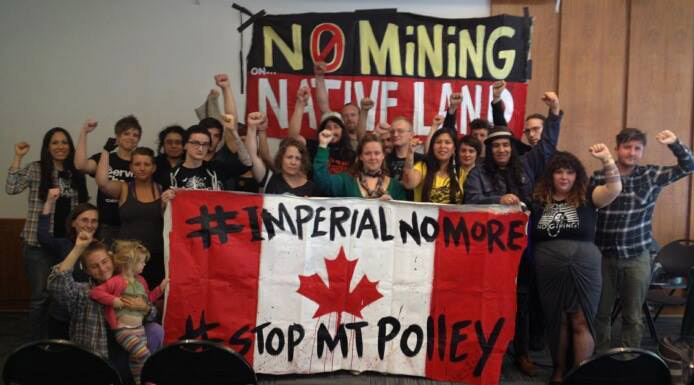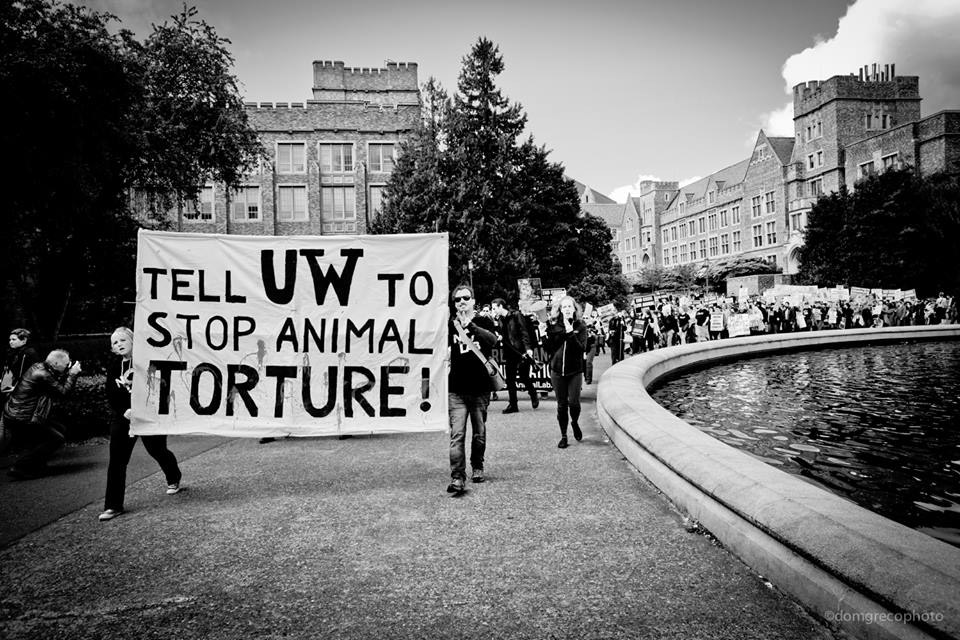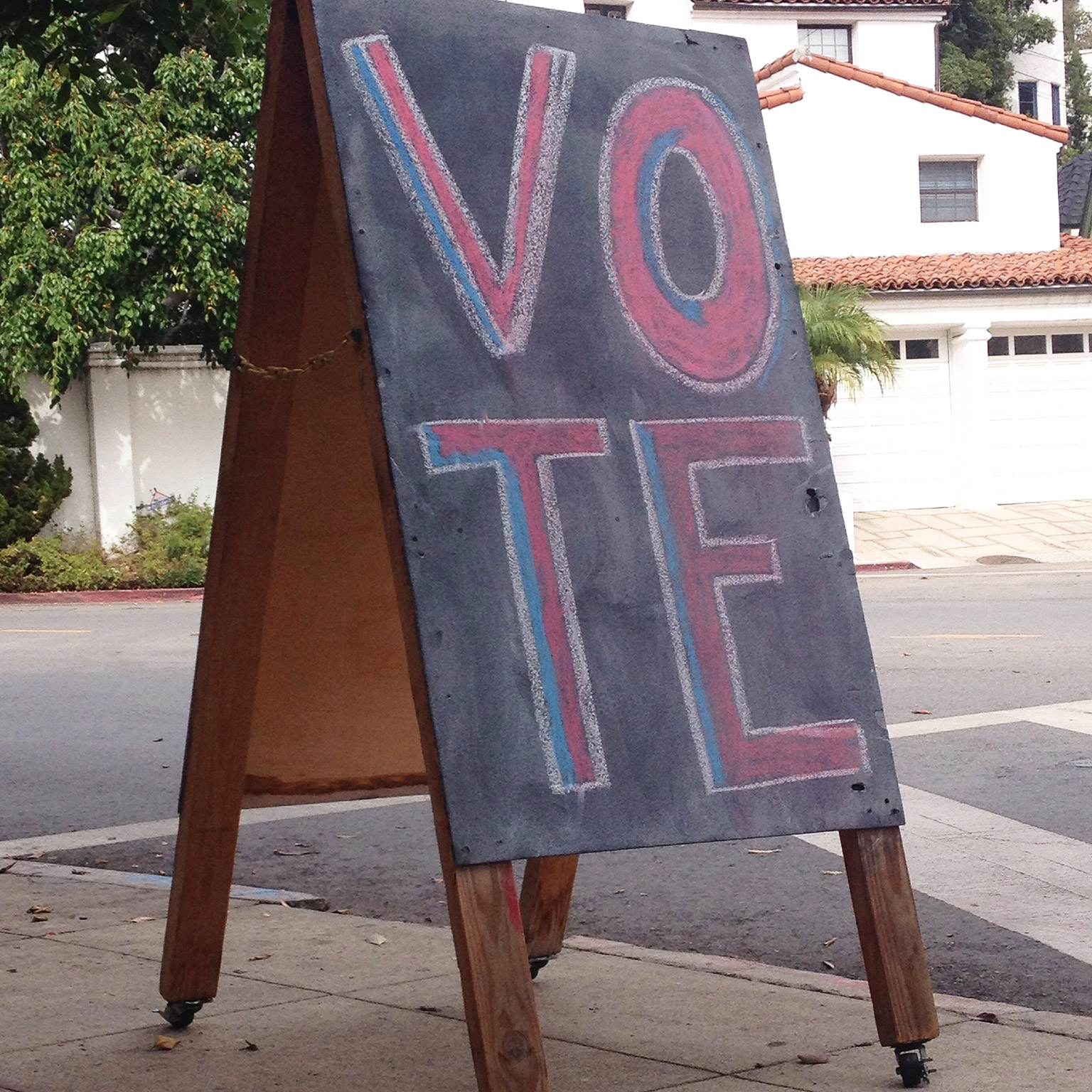Tomorrow, in our role as store-runners and creative directors at MooShoes Los Angeles, we’re hosting the grassroots animal liberation group Resistance Ecology at the store, donating 10% of the day’s sales to their work and, as an added bonus, bringing in Southern Fried Vegan, who will have many of their trademark, delectable vegan versions of popular southern and soul food classics and also donating a portion of sales to RE.
If you’re in the southern California area tomorrow, stop by—we’re at 3116 Sunset in Silver Lake, open 11-7, and serving food until it’s gone.
Leading up to the event, though, we thought we’d take a moment to find out more about Resistance Ecology, the work the group does, and the concept behind it and its work in talking with the group’s co-founder, Justin Kay.
raven + crow: So, first off, tell me about Resistance Ecology. How + when did it form?
Justin Kay: Resistance Ecology formed in 2012 as a response to the absence of grassroots networking and critical analysis in the animal liberation movement. After years of campaigning and action, a group formed in Portland to address these gaps with a focus on radical movement building, coalition building, and solidarity.
And the name—does that speak to the core mission of the group? How was that chosen?
“Resistance Ecology” speaks to the overlapping, interdependent, and specific oppressions that structure the world around us—an “ecology” of oppression. Resistance Ecology developed as a praxis of advocacy that acknowledged the systemic nature of oppression by advancing an approach that is rooted in coalition building and solidarity.
Do you see yourself primarily as an animal rights/liberation group then?
Yes, we still do, because it is important for us to position ourselves in the animal lib movement and avoid the erasure of specific oppressions through a process of uniformity that often results from AR discourse surrounding “intersectionality.” We come from different histories and social positions, specifically as animal advocates, and we need to own that in order to move forward and genuinely talk about solidarity. Solidarity means nothing if we believe we all struggle in the same way.
I definitely get the idea of a holistic approach to these issues that are inevitably connected, but do you ever worry that—as a group—you’re tackling too much or not honing in enough on specific, finite problems and solutions?
Specific problems do not really exist in a vacuum. Animal use does not exist in a vacuum. Pragmatically it is important that advocates can come to see individual campaigns as part of the larger narrative of liberation or resistance, and be able to seat those things in a political and social context. Yes it can be difficult to approach every issue with a structural analysis, but it is foolish to approach issues in the absence of it.
Honestly, reading through your materials, the concepts seem very logical and well-thought-out in an academic way, but I have a hard time visualizing how that’s turned into direct action; not that the higher concept planning and strategy aren’t valuable, just that I envision getting so wrapped up in the talking and planning that little time or energy is left for action. Do you all focus on specific actions or campaign or are you more of a forum for like-minded activists? …or both?
We are both a forum and network of like-minded activists and folks who work on specific campaigns and support specific campaigns. Campaigns and organizations that we support and help to organize, and which reflect our core praxis, include No New Animal Lab (a project of RE), Wildlife Defense League, Food Empowerment Project, and Marineland Animal Defense. We also specifically support and intentionally give space to indigenous land defense campaigns—Unist’ot’en Camp, Madii Lii Camp, Utah Tar Sands Resistance, Apache Stronghold, Klabona Keepers, and Imperial No More—to name a few.
That makes sense. So it’s more about creating this community and common language for the activist community and understanding the interconnectedness of these issues so everyone can take that back to their specific fights. Love that you all work with Food Empowerment Project too—we did that logo for lauren and everyone at FEP a good bit back and have been fans of their work ever since.
We just love lauren and the work that she does and we often give space and support FEP (such as at the conference).
Yeah, it seems like your annual conference is a big part of your work. Can you talk about that and its goals for participants and organizers?
Resistance Ecology really started as a conference. Currently there are almost no grassroots, free, and open to the public animal liberation conferences in the US. The National Animal Rights Conference is not an open or inclusive space. It is structured to keep grassroots activism at bay. It is expensive to attend and to table—several hundred dollars expensive. It only provides space for large nonprofits. It is not representative of the movement we want—not at all. So we started RE as a response to these issues—lack of critical analysis, no meaningful discussion about coalition building or solidarity, unwillingness to critique our failures and obstacles, poor understanding of repression, etc—and we created an alternative.
For three years, the Resistance Ecology Conference has served as a beacon on the path to grassroots animal liberation. We aspire to create a forum to unite animal liberationists, land defenders, and organizers to share skill sets and resources, to report and recruit, to coordinate campaigns, and to promote solidarity, coalition organizing and mass movement building against the structures that underpin animal use and ecological destruction on the continent— Euro-settler colonialism, white supremacy, patriarchy, capitalism, neoliberalism, and border imperialism.
We challenge the professionalization, corporate assimilation, consumer-orientation, and one-dimensional analysis of the so-called animal “rights” movement in the west that is founded in positions of social power and is made possible through settler colonialism, capitalism, and patriarchy. The goal of the conference is to identify these analytical and structural barriers within the animal liberation movement as barriers that prevent us from creating the radical analysis, solidarity, and mass movement necessary to affect meaningful change for animals.
No, I was just talking with someone about how exclusive and ridiculously overpriced the AR National Conference is. It just serves to push the movements further and further into the privileged and elite mentalities. Your 2015 conference just wrapped up a couple weeks ago though—how was it?
The 3rd Annual RECon was a big success. We heard a lot of great feedback from attendees and presenters. Most importantly, it served as a forum for folks to be able to network. Networking is probably the best part of any conference, and by far the most effective. This year was a bit different in that we brought in folks working on indigenous resistance, land defense, decolonization, and anti-colonial struggle so that we could situate animal exploitation on North America in that context. It was going out on a limb for sure, but it paid off well. Relationships were built and difficult discussions were forged. We hope to see some solid, on-the-ground follow up to it all.
In the end, it seems like the 2015 conference is the best representation so far of the movement that we want to help create. There was a bit of a shift away from some of the intellectual foundations, towards a look at what is happening on the ground—physical resistance, occupations, blockades, campaigns, direct action—so that attendees could better conceptualize what a “resistance ecology” would look like temporally, spatially, and strategically.
Lofty but worthy goals, man. Awesome that the conference is free, by the way. How do you pull that off?
We work with a student group at Portland State University—Student Animal Liberation Coalition—who co-organizes the conference and can reserve the space for free. The majority of the organizing collective are students, actually. In reality, though it costs a lot of money, that shouldn’t undermine the obligation to create free and open spaces for movement forums. No conference should cost money. It defeats their entire purpose. The idea that some conferences (such as the National Animal Rights Conference) parade themselves as grassroots yet cost hundreds of dollars, between attendance and tabling and hotel rooms, is one of the biggest jokes that the animal “rights” movement is playing on itself. You’d think that a conference with a budget of over $100,000 dollars could at least provide free and relatively inclusive space. This is the cost of having almost all of our movement resources siphoned by the nonprofit industrial complex, branded with names like PETA, MFA, HSUS, FARM, Humane League, or COK. We literally buy into it. We fall for it over and over.
The solution is to decentralize these movement spaces and forums. Take them back from the “Animal Rights Cartel” and build local and regional capacity and skill sets…find community-run spaces; look into colleges and universities; connect with other communities, organizations, and movements; connect with students. It’s pretty simple and that’s all that we are doing—it’s basic organizing 101. The fact that such advocacy models and organizing capabilities are now so illusory, especially to animal advocates, is a testament to how nonprofits have seriously harmed our movement.
So, outside of conferences themselves, do you see that as a hurdle for many people wanting to be involved in activism these days, the price tag sometimes associated with it?
Absolutely. Movement building means we should be building local skills, resources, and capacity. We currently have a top-down, silo-oriented model of animal advocacy. Resources are funneled, into large established nonprofits with multi-million dollar revenues and paid executive staff, and this causes the grassroots to be hemorrhaging at low capacity. This dynamic helps them to further consolidate power, push their corporate brand, and integrate themselves into to the larger movement. New folks get involved and then think the only way to do activism locally is order some signs and leaflets from one of these organizations. That only perpetuates the cycle. What is lost is the ability of communities to develop skills—writing, journalism, graphic and web design, campaign development, strategy, fundraising—all of which are essential to grassroots organizing. We thus become financially and organizationally dependent on the larger groups, who ironically are sucking our resources dry. It’s the cycle of the nonprofit industrial complex, and is perhaps one the worst hurdles to grassroots mobilizing.
You’ve spoken to this a little already, but, in my more activist-centric youth, one thing we always struggled with in the animal rights, environmental, and feminist communities was the one-dimensionality of our membership—more often than not, it was the white, middle-/upper-class opting in, which invariably guides how you function as a group and the way you impact social change. Do you see that getting better in recent years or do you still view that as a big problem?
It’s still a big problem. The dialogue is getting more visible, due to social media, thoughtful blogs, and solid academics, which is important. It’s the very positioning of animal liberation that leads us down this path though. Until we trace the history of animal use as tangential to European imperial and colonial endeavors, market capitalism, and centralized nation-states, we will inevitably appeal primarily to affluent and privileged communities. We aren’t really challenging power with the analysis that we’ve constructed around animal liberation, so we tend to have a hard time appealing to those whose daily realities are the subjects of power and oppression—people of color, queer and trans folks, indigenous nations, migrants and undocumented folks.
It’s hard to take seriously the suggestion that we’ve made any progress when those in the “Animal Rights Cartel” applaud racists like Sheriff Joe for making his jails vegetarian as a cost-saving measure, praise Israel for vegan boots in the IDF, collude with prosecutors and ICE to deport migrants working in factory farms, or use transphobic analogies to criticize KFC. It’s a joke. As long as anyone supports these organizations, it’s a joke to say we’ve made progress.
Man. This is a lot to digest. How long have you all been doing the magazine, though?
We started the magazine in 2013 along with the first conference.
Is the hope for it that you’re providing an access point to those who can’t make it to the conferences?
That’s part of the intention. It’s also a throwback to days when the movement was scattered throughout social media tirades and rants in the comment section of a blog. We used to have our thoughts and critiques, strategies and tactics, networks and relationships bound in the pages of movement publications like No Compromise, Liberator, Do or Die, Underground, Arkangel, or the Earth First! Journal or in campaign/organization newsletters from SHAC, Save the Hillgrove Cats, or the Liberation Leagues. Again this is all about accessibility—the more ways that folks can learn and get plugged in, the better.
We really like the cover art for the summer 2014 issue. Who did that and how do you seek contributions, in general?
Matt Gauck did the illustration. He has a done a ton of stuff for us and countless other groups doing good work.
For contributions we do a combination of direct asks and soliciting requests for contribution through email lists, social media posts, and website posts.
What are some campaigns coming up that you’re really excited about starting in on this year?
The No New Animal Lab campaign—which is by far the most exciting grassroots animal liberation campaign in the US. It’s a pressure campaign, the vein of SHAC, Hillgrove, and SPEAC, aimed at stopping the construction of a massive centralized animal research facility in Seattle. Check out NoNewAnimalLab.com to learn more.
Well, we’re excited to host you all Saturday. Thanks for taking the time to talk and tell us more about the group.
You can visit RE’s Web site to learn more about the group, their work, and to get involved; if yore in the Los Angeles area, you can also come to MooShoes tomorrow to speak with members of RE—check out the Facebook event page to find out more about the event.
Below, a photo from Resistance Ecology’s most recent conference, just after a panel on land defense and indigenous resistance; a couple shots from the No New Animal Lab campaign 500-person march on the University of Washington; a recent 12-hour lockdown the group caused on the UW lab construction site; and, tot he right, a 32-foot banner an activist hung in a tree on the campus, all photos courtesy of RE.







